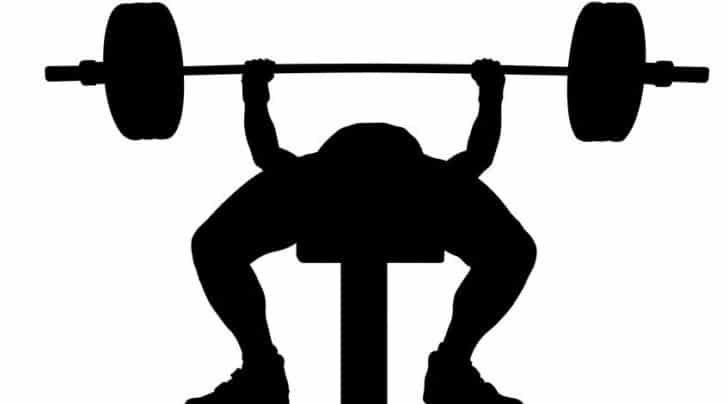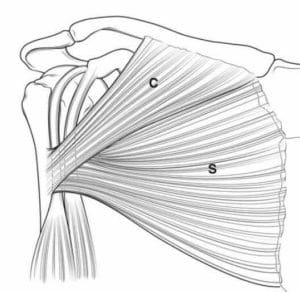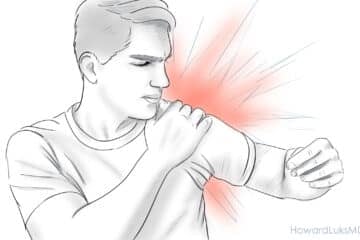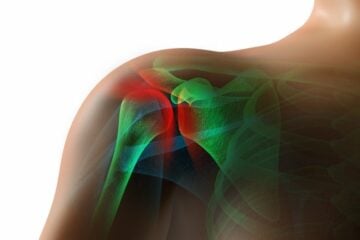
The pectoral tendon attaches the pec major muscle to your humerus or arm bone. The pec major is a very powerful muscle. Pectoral tendons are usually ruptured or torn in weight lifters during bench pressing. Traumatic injuries in sports can also result in a pec tendon tear. Surgery is often needed to repair complete pec tears. The recovery after surgery often means that this is a season-ending injury.
A torn pectoral tendon is usually an easy diagnosis to make. Your story usually goes something like this… You were bench pressing, you heard a series of pops and the bar came back down to your chest rapidly. If that sounds familiar, you have likely torn a pectoral tendon or have pectoralis major rupture. Over the next few days, you will notice heavy bruising and swelling. As the swelling starts to subside, you will see a deformity of your pectoralis major. If you tighten your chest muscles you will see the pec ball up over your chest. A torn pectoral should be repaired (if it is repairable) as soon as possible. If you suspect a pec tendon injury you should see a shoulder doc sooner rather than later.
A torn pectoral tendon tends to occur in “younger” active weight lifters. However, because 50 somethings are lifting more often and more weight we are seeing pec tears in this age group as well. This is an injury we usually see rapidly in our clinic since the injury is quite striking, the deformity is easy to notice and the story you give is always consistent. There is usually significant bruising present and there is usually an obvious deformity noted as your pec major bunches up in your chest.
Like J.J Watt, a torn pec tendon can occur in any collision sport as well. This will be a season-ending injury for Watt. What is the decision making and recovery time frame going forward for J.J Watt and others who have torn their pec tendon?

Types Of Torn Pectoral Tendons?
Tears of the pectoralis major can be partial (just one head) or complete.
In type 1 torn pectoral, the tendon of the pectoralis major tears directly off of the humerus – the easiest to fix.
In type 2 torn pectoral the tear occurred where the muscle starts transitioning into a tendon – the muscle-tendon junction- harder to fix, but still possible.
In type 3 pec ruptures, the tear is completely within the muscle itself. May not be repairable.
In type 4 pec ruptures, the muscle tears off of the sternum.
A Type 1 or Type 2 pec tear is far more common than type 3 or 4.
How Do You Treat A Torn Pectoral Tendon?
Most pec major tendon ruptures occur in very active people. Without surgery, pectoralis major tears will cause weakness and an obvious deformity. Because of that, most people with a pec tear will choose to have them repaired. The pec major is not an absolutely essential muscle, and many of these pec tears are partial tears, so if the loss of strength and the deformity do not bother you then you can be treated without surgery.
How Do You Repair A Torn Pectoral Tendon?
If you choose to have surgery to repair your pec tendon tear then you should understand the following principles.
Type 1 tears where the tendon ripped off the bone are the most straightforward to repair. The surgery is open, and the incision is placed in your axilla. During the surgery, we will use a suture anchor device to place sutures into the bone and then we will use those sutures to repair the tendon back to the bone. You will be in a sling for a while and then start strengthening exercises after enough healing has occurred.
Type 2 tears are more difficult. These tears occur at the “muscle-tendon” junction of the pec major. Muscle tendon junction tears can be very difficult to fix because you can not sew or repair muscle. Often times we wait a little while for some early repair scar tissue to form on the pec muscle which will make the repair easier. Sometimes we might need to augment or strengthen the repair with a cadaver tendon.
Type 3 tears are purely within the muscle. They are very rare and very hard to repair. We must wait a few weeks for scar tissue to form so we have something we can attempt to repair.
Most tears are Type 1 or 2, so most tears are easily repairable. The results of surgery are generally good, and most of you will be pleased with the appearance of the pectoralis and your performance in the gym after you have recovered.
How Long Does Is Recovery From A Torn Pectoral Tendon?
Pectoralis tears generally heal very well. It can take at least 6 months until you are back in the gym and back to your normal routine. It can take a year or more until you have normal strength, although that might occur earlier in many of you.
What Are The Risks Of A Pec Tendon Repair?
No surgery is without risk. The risks include the risks of anesthesia, infection, weakness, stiffness, a recurrent pectoral rupture, an abnormal appearance, nerve or blood vessel injuries.
Do you have questions regarding an Orthopedic injury or longevity?
Do you want to talk to an expert who can listen to you for 45-60 minutes and explain the options in detail?
Dr. Howard Luks offers remote guidance sessions to review your X-ray or MRI images and explain your options.
Dr. Luks has also received hundreds of requests for educational sessions on the topics discussed in his book, Longevity Simplified.
The overall risks of surgery are very low. Below is a video detailing how a pectoral tendon tear is repaired.













Robert Cooper
Hi Dr Luks,
Would the sternal fibres of the pectoralis major ball up and deform in the chest when contracted if the posterior lamina of the tendon were torn (partial tear)? This is what is happening to me. It is clear the clavicular fibres are still attached, but there is certainly a thinning of the axillary fold when I push my hands together in front of my chest to contract the pectoral. I believe I have a full-width, partial-thickness tears of the posterior (sternal) portion. I was bench pressing 5 weeks ago and I felt a pop and pull, then a lot of pain and lost all strength. There was immediate swelling, but very little bruising. I am booking in to see a private specialist as a previous consultant was not interested in seeing anything less than a complete rupture, but I would appreciate your opinion.
Kind regards,
Rob
HI Rob…
Yes… a partial tear of the sternal head will create that deformity.
Robert Cooper
Thank you for replying. I thought as much, but have not found any sources to support this.
Phil
Hi Dr Luks,
Great site, thanks for all the info. Is it possible to have a very minor pec tear? A few weeks ago I was doing bench and felt a bit of pain on the medial part of my humerus right below my armpit during the concentric push. There was also a little pain around the middle/upper two inches of the lateral part of my pec.(no bruising or deformity that I could/can notice) I have avoided push movements since and the only movement that really bugs the humerus area is being fully extended and passively hanging in the supine chin up position.
I understand it is tough to say without seeing for yourself but do you think rest and eventual light stretching/rolling of the area is the best course of action moving forward?
Thanks,
Phil
Yes, you can have partial pec tears. Some partial tears are tiny, some include 1/2 the pec muscle. It is best if you are examined and an actual diagnosis is confirmed. if it is a partial tear you do not want to risk it becoming a full tear if you return too soon
Phil
Sounds good, I will get it checked out.
Thanks for the reply,
Phil
Jose valencia
Good evening Dr. Luks, I ruptured my pec tendon early this year in May 2019. Dr. Says 90% of the pec tendon tore off the humerus and about 90% at the junction tore as well, along with some pec muscle damage. Needless to say I was benching 355lbs wide grip on bench press.. A week after the injury I had surgery and the surgery was a success. Today I have good symmetry, full mobility and SLOWLY gaining my strength back ( can now bench 105). November 15 will be the 6 month point and till this day I still have this pain at the anchoring site. When I firmly apply pressure to it. I can palpate an approx. 1cm ball (mass) right in the anchoring site and that is what hurts. No pain when engaged in rang of motion nor while at work or physical activity. Any insight on what this might be . Scar tissue? Is pain normal at the 6 month mark? Any feedback would be greatly appreciated! Best regards!
Jeff Fernandez
Hi Dr Luks, I injured my Pectoralis major on 9/24/2019. I had an MRI a few days ago, waiting on insurance prior auth to see surgeon this week, MRI says “ Full Thickness tear of the distal myotendinous junction of the right Pectoralis muscle , with 3.7cm of retraction of the torn fibers. Associated right Pectoralis muscle strain.”.
I was wondering if u could decipher that in layman’s terms and tell me what type tear I have ..?
You have a muscle-tendon junction tear. Many of those can be repaired. good luck!
Moe F
Had right Pectoralis shoulder surgery June 24 I start physical therapy when can I start going to the gym working out body parts minus the chest area like back biceps shoulders legs and triceps if I have full range of motion
I wouldn’t start doing those until your surgeon says it is ok. Otherwise, you could tear the tendon again.
Pakinai
Tore something during bench press a 9 days ago. Eccentric part where I was about to press up,a pop like2-3times,pain under armpit.Had two MRI scan both on shoulder and chest ,result came in as subscapularis 50% tear and coracobrachialis20% tear but no pectoralis major tear.But the area where anterior axillary fold use to be is gone and when i flex my pec its definitely ball up and there’s a hole Inbetween armpit area,. Is the MRI result wrong?
Yes… MRI results can be wrong. There are second opinion services online that you can upload your MRI to. Or you can see a shoulder doc, many of whom will read their own MRI.
tim
Hello Dr. Lukas.
i tore my pectoralis tendon 4 weeks ago and again 1 week ago. is it possible to tear just the clavicular head and not the sternal head? Can MRI differentiate between which head was torn or is this something that can only be diagnosed during surgery? Is the prognosis better if the clavicular head and not the sternal head is torn? i have dimpling of the anterior axillary fold but the the bruising tracked the clavicular head up to the clavical and i still have some strength which is the reason i think the sternal head might be spared. my MRI is in 2 days. i’m scared of surgery because it’s an uncommon injury and most orthopedic surgeons i have talked to have never done this type of surgery or it has been 10+ years.
Hi Tim .. I don’t know where you live, but in busy urban/city regions this isn’t a very uncommon injury.
The bruising will not give you a clue about which head is involved. If you lost the axillary contour then at minimum your clavicular head is torn. The MRI can tell you if it’s a partial or complete tear. It is not a challenging repair to perform if it is a tendon tear. For muscle tendon junction injuries it can be challenging for anyone to perform.
Rondell
This is a very cool site. Good to see engaged doctors.
I just had my repair 4 weeks ago and am on the mend. I tore mine in a pretty gnarly skiing accident. Just stopped wearing my slight but still take it out in heavily trafficked areas for precaution.
When can I start strength training with slight resistance and using light bands? Should I still be icing it everyday?
Icing this far out is generally not needed. AS far as strengthening that depends on how robust your tissue was and where the tear occurred. Only your surgeon knows the answer to that. In general, we wait 6-10 weeks to start strengthening exercises depending on the variables I mentioned earlier.
Matt
Hi Dr. Lucas, I just recently tore my pectoral muscle on 12/6/18 and because no one could cover me at work my surgery won’t be until 12/26/18. Is this delay going to affect the outcome of my surgery?
It can Matt … but at 3-4 weeks it should still be fairly easy to repair depending on the type of tear it is.
Timothy Hockley
Dear Dr lucas, I have a complete tear of the right pec, type 2 at the tendon and muscle. I know now that surgery maybe highly unlikely. My question is symetry. I want to compete at least one time in a body building contest but the lump is just very ugly. Do you know of any plastic surgery or any surgery like that which could remove the lump or cut it down or anything like that. Also in your opinon will stem cell therapy ever be able to help. Thanks.
Best is to have someone experienced in these injuries to look and see if a repair is possible. Muscle tendon junction injuries are harder to fix, but not impossible. There is a chance that surgical repair can restore a more normal contour to your pec.
Good luck .
Edgar Pimentel
Hello, I had a partial pec tear about 4 weeks ago. My MRI showed a grade 1 tearing of the pec muscle. I am currently having physical therapy and my DR said I would not require surgery. I participate in strongman as a hobby and I am worried I might need surgery to heal 100%. Should I see an orthopedic surgeon and get a 2nd opinion? The tear is small at the shoulder area of the pec.
If you are concerned then go for that second opinion.
Good luck
TERRY C
So yesterday while benching just like everyone else felt something go wrong as I was going up with the weight. Sounded like a little bubble wrap was happing in my left chest . I have torn my bicep before and heard the loud pop and that did not happen . No bruising or discolor just a tender/sore. Range of motion was better than when it happened. The are that’s tender would be between my arm pit ( not sore to touch) and left side I guess the halfway mark.. Can still flex my pecs ( not without discomfort of course)
Time to see a sports doc to figure out if you have a pec tear. It could be partial which could explain why you have no deformity.
Andrew Brew
I tore my pectoral muscle last week friday 8/3/2018. My mri is on next Monday 8/13/2018! I’m nervous that the process to get surgery is taking too long and I don’t want my injury to start healing incorrectly. When is surgery way too late? Thank you Dr. Luks.
Many surgeons who are comfortable in this area can fix this many weeks after the injury.
Andrew Brew
Thank you for the reply. I appreciate you creating this platform. Very kind of you sir.
Obioma Nkwuo
I tore my pec 5 years ago. My armpit looked very thin and my pec muscle is pushed towards the center of my chest. However, I am lifting 205 for incline bench and I have gained a lot of my strength back. Does this indicate that it was only a partial tear? Is it risky for me to lift heavy again. It took me 2 years to really gain strength back, I was very careful. I did not have medical coverage and I couldn’t afford to miss work for 6 weeks therefore I never had an MRI
You may have had a partial tear (sternal portion vs clavicular portion). Without examining you I couldn’t say.
If you are pushing heavy weight with a smaller tendon/muscle then there is a risk of injury if you push too hard or lift too much weight.
Matthew James
Hello Dr Luks,
I was misdiagnosed for 10.5 weeks for a pec tear and I am now 2 weeks post surgery.
I understand with rehab and time that strength can take some time to return, but I was wondering has three ever been any cases where strength has never returned 100% or any prologning issues such as pain?
Also will a pec that has been repaired always have a greater risk of being torn again?
Thank you
Hi ,
Torn muscles or tendons might someday return to normal strength… but most usually will lose one grade in strength. That may not be perceptible to most. Pain as a long term sequelae of a pec repair is unusual.
Re-tears are not very common after pec repairs… but they are possible. Especially in the first year. Ie… do not push too hard during first 12 months. Follow your docs instructions well.
Kevin Hall
Hi Dr. Luks. My 16-year-old son was just diagnosed with a pectoralis major rupture. He undergoes his MRI today. Is there any chance that he’s ready to play football in June of this year? Does that depend on what is revealed in the MRI, or is football off the table for next season? He’s bummed, to say the least. Thanks
Hi Kevin …
We typically wait 6-8 months after a repair for a return to contact sports. So depending on the MRI findings, and the type of treatment he needs he may be be able to go back.
Mike Perl
Dr Luks:
I was just diagnosed with a tear of the myotendinous junction of the sternum head of the pec major with slight medial retraction. The distal tendon fibers remain intact. The injury occurred 4 months ago and due to my schedule I would prefer to have surgery in 3 months. Is this what you call a type 2 tear? Does waiting an additional 3 months matter? Can I incur additional injury by working out over the next 3 months? Any other advice? Many thanks.
The longer you wait the more difficult it often is to repair.
Anthony
Dr. Luks,
While bench pressing 6 days ago my right arm gave out after I felt a snap on my right shoulder. It was not very painful but I went to the hospital immediately. I saw a doctor and he had me push against his hand and raise my arm. He felt around my pec and said he could not feel the tear and since I could push with my arm and raise it it was not fully torn and surgery was not necessary. The next few days my bicep was black and blue and chest was sore . There is a slight asymmetry between my two pecs but it seems to be getting better everyday. In your opinion, what should I do? He doctor said it was very minor, can the muscle and tendon connection regenerate? Thanks so much.
Best,
Anthony
Have it looked at sooner rather than later. If it is torn it needs to be treated within a few weeks of injury for best possible results.
Partial tears will not have same appearance as full tears and can fool some folks on examination.
Jesse Eggman
Hi Anthony, That is similar to what happened to me. Two doctors told me I was probably ok and one said even though there was tearing I didn’t need surgery. I knew something was wrong because when I picked up my arm like I was flexing my bicept (fist by my temple and elbow out away from my body)💪 the outside of my pec felt soft where it used to be hard. A sports medicine doc had me get an x ray and MRI. The MRI showed a complete tear of my pectorals major. I just had surgery on it two days ago ( about three weeks after it happened). My orthopedic surgeon said you can do the repair up to two years After the injury occurs. It seems that the MRI is what tells you what’s really happened more than anything else since I was not in severe pain and could put pressure against the docs hands as well. I could even do a push-up although it was painful.
Jerry Rice
Dr. Luks,
I believe I have torn my pec, I have had my MRI and my orthopedic doctor can’t quite figure out if it’s completely torn, or where its torn. We are waiting for the radiologist to look at it. I’m just worried about whether or not it’s a type 1 tear or type 2. Is there any way I can determine that by looking or feeling?
Sometimes we can tell by examination… but the MRI or ultrasound is critical to show the site of a pec rupture.
Drew Whelchel
Hi Dr. Luks,
I have a type 2 pec tear from 5 weeks ago. Is it possible for the muscle to repair/regenerate back to normal for a symmetric chest without surgery?
Thanks
Unfortunately no
Jacob Wagner
Dear Dr. Luks,
I’m writing to inquire about how long is too long to wait to have a torn pec repaired. Approximately 5 1/2 years ago I tore some portion of my left pec while doing a heavy bench press that I wasn’t fully warmed up for. Based on your descriptions, it seems like a pretty standard tear: pop, severe pain, bruising, and a bunched up muscle which flexes like a little ball on my chest. I was deployed overseas at the time and unable to get immediate care beyond pain meds. Six months later when i returned I saw a doctor to ask for surgery, but he said that the tear wasn’t a complete tear and that surgery wouldn’t help. However, it seemed that he simply didn’t have experience with it. Either way, I resided myself to the fact that i’d only have 1 fully functioning pec. This had a majorly negative impact on my sports training over the last several years. I’m reaching the limitations of what I can do with it, and i’m afraid the imbalance will cause other problems. Is 6 years too late to repair it? Would it be worth my time to seek out a surgeon who has experience with this?
Thank you,
Jake W.
Most of us consider 2-3 weeks a long time. The pec tendon tends to scar down in its new home making a repair difficult. Late reconstructions are perhaps considered possible by some, but the results are often less than satisfactory– esp 5 years after the initial injury.